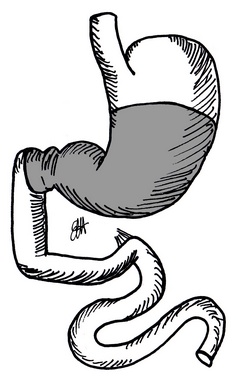The Billroth I procedure was pioneered by Dr. Theodor Billroth in 1881. The original procedure was described as a "subtotal gastrectomy" where gastrointestinal continuity after the resection was attained with an anastomosis between the stomach and the duodenum, a gastroduodenostomy.
The procedure was originally performed as a way to resect peptic ulcers caused by hyperacidity. Billroth removed up to 70% of the stomach. Modern variations of the procedure are less agressive, resecting only 50% of the distal stomach (a hemigastrectomy), or an antrectomy.
After Billroth's pioneering work, several variations on the procedure appeared (Polya, Hofmeister) as well as different techniques (open vs. laparoscopic), and the use of different materials, starting with carbolized silk to the modern endolaparoscopic surgical staplers.
The accompanying image shows the digestive tract before the resection. The area to the resected (specimen) is grayed out. If you hover your cursor over the image you will see the completed Billroth I procedure.
In the completed procedure you can see A: The stapled-closed proximal gastric pouch. B: The duodenum. The red arrow points to the gastroduodenostomy, that is, the anastomosis between the stomach and the duodenum which in this case was done in the posterior aspect of the proximal gastric pouch. Bear in mind that this sketch depicts only one of the many ways of performing this procedure
Images property of: CAA.Inc. Artist:Dr. E. Miranda




